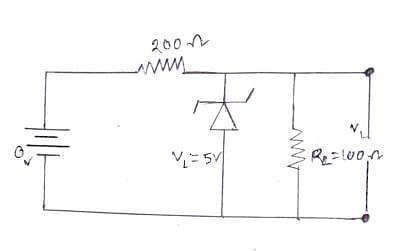A transistor is used in an amplifier circuit in common emitter mode. If the base current changes by 100μA, it brings a change of 10mA in collector current. If the load resistance is 2kΩ and input resistance is 1kΩ, the value of power gain is \(x×10^4\). The value of x is _______.
Correct Answer: 2
Solution and Explanation
The correct answer is: 2
Power gain
\(=[\frac{\triangle{ic}}{\triangle{iB}}]×\frac{R_0}{R_i}\)
\(=[\frac{10^{-2}}{10^{-4}}]×\frac{2}{1}\)
= 2 × 104
\(⇒ x = 2\)
Top Questions on Amperes circuital law
- A coil has a resistance of \( 30 \, \Omega \) and an inductive reactance of \( 20 \, \Omega \) at 50 Hz frequency. If an AC source of 200 V and 100 Hz is connected across the coil, then how much current will flow through the coil?
- MHT CET - 2024
- Physics
- Amperes circuital law
- In a series LCR circuit connected to an AC source, at resonance, the current is maximum because:
- MHT CET - 2024
- Physics
- Amperes circuital law
Consider the circuit shown :
 The ammeter reads 0.9 A. Value of R is
The ammeter reads 0.9 A. Value of R is- JEE Main - 2024
- Physics
- Amperes circuital law
- Among the following, Ampere’s circuital law is represented by:
- AP EAPCET - 2023
- Physics
- Amperes circuital law
- In the given circuit, find the voltage drop VL in the load resistance RL

- WBJEE - 2023
- Physics
- Amperes circuital law
Questions Asked in JEE Main exam
Given below are two statements:
Statement (I):
 are isomeric compounds.
are isomeric compounds.
Statement (II): are functional group isomers.
are functional group isomers.
In the light of the above statements, choose the correct answer from the options given below:- JEE Main - 2025
- Isomerism
- Let ABC be a triangle formed by the lines \( 7x - 6y + 3 = 0 \), \( x + 2y - 31 = 0 \), and \( 9x - 2y - 19 = 0 \). Let the point \( (h, k) \) be the image of the centroid of \( \triangle ABC \) in the line \( 3x + 6y - 53 = 0 \). Then \( h^2 + k^2 + hk \) is equal to:
- JEE Main - 2025
- Coordinate Geometry
- For a reaction, $$ {N}_2{O}_5(g) \rightarrow 2{NO}_2(g) + \frac{1}{2} {O}_2(g) $$ in a constant volume container, no products were present initially. The final pressure of the system when 50% of the reaction gets completed is:
- JEE Main - 2025
- Chemical Reactions
- If the image of the point $ P(1, 0, 3) $ in the line joining the points $ A(4, 7, 1) $ and $ B(3, 5, 3) $ is $ Q(\alpha, \beta, \gamma) $, then $ \alpha + \beta + \gamma $ is equal to:
- JEE Main - 2025
- 3D Geometry
Among the following cations, the number of cations which will give characteristic precipitate in their identification tests with
\(K_4\)[Fe(CN)\(_6\)] is : \[ {Cu}^{2+}, \, {Fe}^{3+}, \, {Ba}^{2+}, \, {Ca}^{2+}, \, {NH}_4^+, \, {Mg}^{2+}, \, {Zn}^{2+} \]- JEE Main - 2025
- Qualitative Analysis
Concepts Used:
Amperes circuital law
According to Ampere’s law, magnetic fields are related to the electric current that is produced in them. This law specifies that the magnetic field is associated with a given current or vice-versa, provided that the electric field doesn’t change with time.
Ampere’s circuital law can be written as the line integral of the magnetic field surrounding the closed loop which is equal to the number of times the algebraic sum of currents passing through the loop.

According to the second equation, if the magnetic field is integrated along the blue path, then it is equal to the current enclosed, I.
The magnetic field doesn’t vary at a distance r because of symmetry. The path length (in blue) in figure 1 has to be equal to the circumference of a circle,2πr.
